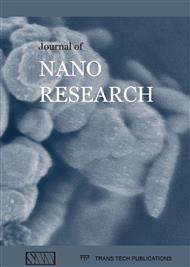[1]
Rosi NL, Mirkin CA, Nanostructures in biodiagnostics, Chem ReV. 105 (2005) 1547-1562.
DOI: 10.1021/cr030067f
Google Scholar
[2]
Jain PK, Lee KS , El-Sayed IH , El-Sayed MA, Calculated absorption and scattering properties of gold nanoparticles of different size, shape, and composition: applications in biological imaging and biomedicine, J. Phys. Chem. B. 110 (2006).
DOI: 10.1021/jp057170o
Google Scholar
[3]
Marinakos SM, Shultz DA, Feldheim DL, Au particles as templates for the synthesis of hollow conductive polymer nanocapsules, Adv. Mater. 11 (1991) 34-37.
DOI: 10.1002/(sici)1521-4095(199901)11:1<34::aid-adma34>3.0.co;2-i
Google Scholar
[4]
Yu Y, Kant K, Shapter JG, Jonas AM, Dusan L, Gold nanotube membranes have catalytic properties, Micropor Mesopor Mat. 153 (2012) 131-136.
DOI: 10.1016/j.micromeso.2011.12.011
Google Scholar
[5]
Xia YN, Xia XH, Wang Y, Xie SF, Shape-controlled synthesis of metal nanocrystals, Mrs Bulletin. 38 (2013)335-344.
DOI: 10.1557/mrs.2013.84
Google Scholar
[6]
Jana N R , L Gearheart, C J Murphy, Wet chemical synthesis of high aspect ratio cylindrical gold nanorods, J. Phys. Chem. B. 105 (2001) 4065-4067.
DOI: 10.1021/jp0107964
Google Scholar
[7]
Jana N R, L Gearheart, C J Murphy, Seeding growth for size control of 5−40 nm diameter gold nanoparticles, Langmuir. 17 (2001) 6782-6786.
DOI: 10.1021/la0104323
Google Scholar
[8]
Nikoobakht B, El-Sayed M A, Preparation and growth mechanism of gold nanorods (NRs) using seed-mediated growth method, Chem. Mater. 15 (2003) 1957-(1962).
DOI: 10.1021/cm020732l
Google Scholar
[9]
Ji C, Searson P C, Synthesis and characterization of nanoporous gold nanowires, J. Phys. Chem. B. 107 (2003) 4494-4499.
DOI: 10.1021/jp0222200
Google Scholar
[10]
Pei L, K. Mori, M. Adachi, Formation process of two-dimensional networked gold nanowires by citrate reduction of AuCl4- and the shape stabilization. Langmuir. 20 (2004) 7837-7843.
DOI: 10.1021/la049262v
Google Scholar
[11]
B K Pong, H I Elim, J X Chong, W Ji, B L Trout, J Y Lee, New insights on the nanoparticle growth mechanism in the citrate reduction of gold(III) salt: formation of the Au nanowire intermediate and its nonlinear optical properties. J. Phys. Chem. C. 111 (2007).
DOI: 10.1021/jp068666o
Google Scholar
[12]
J E Millstone, S Park, K L Shuford, L Qin, G C Schatz, C A Mirkin, Observation of a quadrupole plasmon mode for a colloidal solution of gold nanoprisms, J. Am. Chem. Soc. 127 (2005) 5312-5313.
DOI: 10.1021/ja043245a
Google Scholar
[13]
X Sun, S Dong, E Wang, High-yield synthesis of large single-crystalline gold nanoplates through a polyamine process, Langmuir. 21 (2005) 4710-4712.
DOI: 10.1021/la047267m
Google Scholar
[14]
F Kim, S Connor, H Song, T Kuykendall, P Yang, Platonic gold nanocrystals, Angew. Chem. Int. Ed. 43 (2004) 3673-3677.
DOI: 10.1002/anie.200454216
Google Scholar
[15]
C S Ah, Y J Yun, H J Park, W Kim, D H Ha, W S Yun, Size-controlled synthesis of machinable single crystalline gold nanoplates, Chem. Mater. 17 (2005) 5558-5561.
DOI: 10.1021/cm051225h
Google Scholar
[16]
N Basavegowda, A Idhayadhulla, Y R Lee, Phyto-synthesis of gold nanoparticles using fruit extract of Hovenia dulcis and their biological activities, Ind Crop Prod. 52 (2014) 745-751.
DOI: 10.1016/j.indcrop.2013.12.006
Google Scholar
[17]
Garg N, Scholl C, Mohanty A, Jin R, The role of bromide ions in seeding growth of Au nanorods, Langmuir. 26 (2010) 10271-10276.
DOI: 10.1021/la100446q
Google Scholar
[18]
Millstone JE, Wei W, Jones MR, Yoo H, Mirkin CA, Iodide ions control seed-mediated growth of anisotropic gold nanoparticles, Nano Lett. 8 (2008) 2526-2529.
DOI: 10.1021/nl8016253
Google Scholar
[19]
El-Sayed MA. Some interesting properties of metals confined in time and nanometer space of different shapes, Acc. Chem. Res. 34 (2001) 257-264.
DOI: 10.1021/ar960016n
Google Scholar
[20]
Zong RL, Zhou J, Li Q, Du B, Li B, Fu M, Qi XW, Li LT, Buddhudu S, Synthesis and optical properties of silver nanowire arrays embedded in anodic alumina membrane, J. Phys. Chem. B. 108 (2004) 16173-16716.
DOI: 10.1021/jp0474172
Google Scholar
[21]
Langille M R, Personick M L, Mirkin C A, Plasmon-Mediated Syntheses of Metallic Nanostructures, Angew. Chem. Int. Edit. 52 (2013) 13910-13940.
DOI: 10.1002/anie.201301875
Google Scholar
[22]
Amendola V, Meneghetti M, Size evaluation of gold nanoparticles by UV-vis spectroscopy, J. Phys. Chem. C. 113 (2009) 4277-4285.
DOI: 10.1021/jp8082425
Google Scholar
[23]
Magnussen OM, Ocko BM, Adzic RR, Wang JX, X-ray diffraction studies of ordered chloride and bromide monolayers at the Au(111)-solution interface, Phys. Rev. B. 51 (1995) 5510-5513.
DOI: 10.1103/physrevb.51.5510
Google Scholar
[24]
A Rai, A Singh, A Ahmad, M Sastry, Role of halide ions and temperature on the morphology of biologically synthesized gold nanotriangles, Langmuir. 22 (2006) 736-741.
DOI: 10.1021/la052055q
Google Scholar
[25]
S E Lohse, N D Burrows, L Scarabelli, L M Liz-Marzán, C J Murphy, Anisotropic noble metal nanocrystal growth: The role of halides, Chem. Mater. 26 (2014) 34-43.
DOI: 10.1021/cm402384j
Google Scholar
[26]
J S DuChene, W Niu, J M Abendroth, Q Sun, W Zhao, F Huo, W D Wei, Halide anions as shape-directing agents for obtaining high-quality anisotropic gold nanostructures, Chem. Mater. 25 (2013) 1392-1399.
DOI: 10.1021/cm3020397
Google Scholar
[27]
T H Ha, H Koo, B H Chung, Shape-controlled syntheses of gold nanoprisms and nanorods influenced by specific adsorption of halide Ions, J. Phys. Chem. C. 111 (2007) 1123-1130.
DOI: 10.1021/jp066454l
Google Scholar
[28]
Cheng W, Dong S, Wang E, Iodine-induced gold nanoparticle fusion /fragmentation/ aggregation and iodine-linked nanostructured assemblies on a glass substrate, Angew. Chem. Int. Ed. 42 (2007) 449-452.
DOI: 10.1002/anie.200390136
Google Scholar


